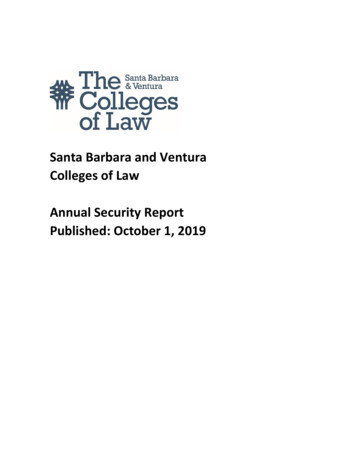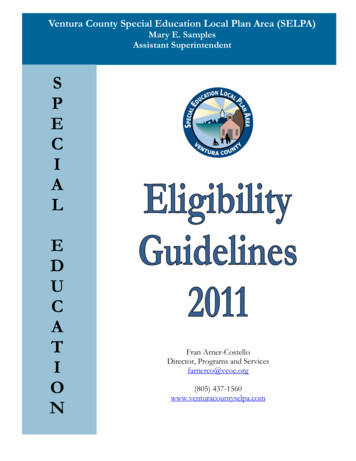
Transcription
Ventura County Special Education Local Plan Area (SELPA)Mary E. SamplesAssistant SuperintendentSPECIALEDUCATIONFran Arner-CostelloDirector, Programs and Servicesfarnerco@vcoe.org(805) 437-1560www.venturacountyselpa.com
SPECIAL EDUCATION ELIGIBILITY GUIDELINESTABLE OF CONTENTSI.FOREWORD . 3II.CATEGORIES OF DISABILITIES AS LISTED IN FEDERAL LAWAutism . 4Deaf/Blindness . 10Deafness . 11Emotional Disturbance . 13Hearing Impairment . 17Intellectual Disabilities . 19Multiple Disabilities . 21Orthopedic Impairment . 22Other Health Impairment. 24Specific Learning Disability . 26Speech or Language Impairment . 35Traumatic Brain Injury . 40Visual Impairment . 42III.ADDITIONAL ELIGIBILITY CRITERIAEligibility Criteria for Individuals with Exceptional Needs Between the Ages of Three &Five Years, Inclusive . 45Individuals with Exceptional Needs Birth through Two Years Old . 48IV.ASSESSMENT INSTRUMENTS BY AREA . 55V.DYSLEXIAWhen do children with this disability qualify for special education? . 59VI.ATTENTION DEFICIT DISORDERSWhen do children with this disorder qualify for special education? . 60VII.LOW INCIDENCE DISABILITIES . 61VIII.DEFINITION OF “SEVERELY DISABLED" . 63IX.ASSESSMENT OF AFRICAN AMERICAN PUPILS – VENTURA COUNTY SELPAGUIDELINES . 64X.INDEPENDENT EDUCATIONAL EVALUATIONS (ASSESSMENTS) . 69XI.REFERENCES . 722
FOREWORDThis document is a compilation of Federal and State legal references regarding special educationeligibility criteria. Also included are suggested assessment and educational considerations foreach handicapping condition.This document is not meant to deviate from Federal or State criteria. It is important to rememberthat regardless of eligibility, special education programming is determined only after an IEPTeam has convened and determined goals and objectives.In addition to eligibility criterias noted, please note that California Code of Regulations (CCR)Title 5 states:3030. A pupil shall qualify as an individual with exceptional needs,pursuant to Section 56026 of the Education Code, if the results of theassessment as required by Section 56320 demonstrate that the degree ofthe pupil's impairment as described in Section 3030 (a through j) requiresspecial education in one or more of the program options authorized bySection 56361 of the Education Code. The decision as to whether or notthe assessment results demonstrate that the degree of the pupil’simpairment requires special education shall be made by the individualizededucation program team, including assessment personnel in accordancewith Section 5634(d) of the Education Code. The individualized educationprogram shall take into account all the relevant material which isavailable on the pupil. No single score or product of scores shall be usedas the sole criterion for the decision of the individualized educationprogram team as to the pupil's eligibility for special education.(Underlines added.)Also, Code of Federal Regulations (CFR) Section 300.7(a) 1 states:As used in this part, the term child with a disability means a child evaluated inaccordance with §§300.530-300.536 as having intellectual disabilities, a hearingimpairment including deafness, a speech or language impairment, a visualimpairment including blindness, serious emotional disturbance (hereafter referred toas emotional disturbance), an orthopedic impairment, autism, traumatic brain injury,an other health impairment, a specific learning disability, deaf-blindness, or multipledisabilities, and who, by reason thereof, needs special education and related services.3
AUTISMA.DEFINITIONS1. FederalPL 108-476 (IDEA), Title 34, CFR, 300.8 (c)(1)"Autism" means a developmental disability significantly affecting verbal andnonverbal communication and social interaction, generally evident before age 3, thatadversely affects a child’s educational performance. Other characteristics oftenassociated with autism are engagement in repetitive activities and stereotypedmovements, resistance to environmental change or change in daily routines, andunusual responses to sensory experiences. The term does not apply if a child’seducational performance is adversely affected primarily because the child has anemotional disturbance, as defined in paragraph (b)(4) of this section.A child who manifests the characteristics of “autism” after age 3 could be diagnosedas having “autism” if the criteria in paragraph (c)(1)(i) of this section are satisfied.2. StateCCR, Title 5, Section 3030(g)A pupil exhibits any combination of the following autistic-like behaviors, to includebut not limited to:(1)An inability to use oral language for appropriate communication.(2)A history of extreme withdrawal or relating to people inappropriately andcontinued impairment in social interaction from infancy through earlychildhood.(3)An obsession to maintain sameness.(4)Extreme preoccupation with objects or inappropriate use of objects or both.(5)Extreme resistance to controls.(6)Displays peculiar motoric mannerisms in motility patterns.(7)Self-stimulating, ritualistic behavior.3. Diagnostic Statistical Manual (DSM) IV Definitions (DSM-IV and Proposed DSMV)According to the Diagnostic and Statistical Manual of Mental Disorders, FourthEdition (DSM-IV):4
A. A total of six (or more) items from (1), (2), and (3). With at least two from (1),and one each from (2) and (3):(1)(2)(3)Qualitative impairment in social interaction, as manifested by at least two ofthe following:(a)Marked impairment in the use of multiple nonverbal behaviors such aseye-to eye gaze, facial expression, body postures, and gestures toregulate social interaction.(b)Failure to develop peer relationships appropriate to developmentallevel(c)A lack of spontaneous seeking to share enjoyment, interests, orachievements with other people (e.g., by a lack of showing, bringing,or pointing out objects of interest)(d)Lack of social or emotional reciprocityQualitative impairments in communication as manifested by at least one ofthe following:(a)delay in, or total lack of, the development of spoken language (notaccompanied by an attempt to compensate through alternative modesof communication such as gesture or mime)(b)in individuals with adequate speech, marked impairment in the abilityto initiate or sustain a conversation with others(c)stereotyped and repetitive use of language or idiosyncratic language(d)lack of varied, spontaneous make-believe play or social imitative playappropriate to developmental levelRestricted repetitive and stereotyped patterns of behavior, interests, andactivities, as manifested by at least one of the following:(a)encompassing preoccupation with one or more stereotyped andrestricted patterns of interest that is abnormal either in intensity orfocus(b)apparently inflexible adherence to specific, nonfunctional routines orrituals(c)stereotyped and repetitive motor mannerisms (e.g., hand or fingerflapping or twisting, or complex whole-body movements)(d)persistent preoccupation with parts of objectsB. Delays or abnormal functioning in at least one of the following areas, with onset5
prior to age 3 years: (1) social interaction, (2) language as used in socialcommunication, or (3) symbolic or imaginative play.C. The disturbance is not better accounted for by Rett’s Disorder or ChildhoodDisintegrative Disorder.Proposed changes to the DSM V Section 299.0AUTISTIC DISORDER1. Clinically significant, persistent deficits in social communication and interactions, asmanifest by all of the following:a. Marked deficits in nonverbal and verbal communication used for socialinteraction:b. Lack of social reciprocity;c. Failure to develop and maintain peer relationships appropriate to developmentallevel2. Restricted, repetitive patterns of behavior, interests, and activities, as manifested by atleast TWO of the following:a. Stereotyped motor or verbal behaviors, or unusual sensory behaviorsb. Excessive adherence to routines and ritualized patterns of behaviorc. Restricted, fixated interests3. Symptoms must be present in early childhood (but may not become fully manifestuntil social demands exceed limited capacities)B.ASSESSMENT STANDARDS1. Assessment will be conducted by a multidisciplinary team as specified in theAssessment Plan, and may include:a.A comprehensive developmental history conducted by a credentialed schoolnurse or other qualified individual. (To determine age of onset.)b.A current psychological assessment conducted by a credentialed schoolpsychologist or other qualified individual.c.A current language assessment conducted by a Speech-Language Pathologist orother qualified individual.d.A current assessment by an Occupational Therapist in conjunction with theteacher and parent regarding sensory issues and needs.e.Previous school history and education progress (when applicable).2. Assessment of young children with autism.6
a.A thorough assessment of young children with autism is essential for planningan appropriate program for the child and family.b.At the infant program level (ages birth through 2), assessment may beconducted by a combined team of school district infant specialist and regionalcenter personnel, in conjunction with the family. Using the Multidisciplinary,Multiagency Team Assessment process.c.At the preschool level, a school district team consisting of appropriate personnelwill assess children. Family members are included as an essential part of theteam, and are encouraged to participate in assessment at a level that theychoose.The following ASSESSMENT PROCESS is essential for young children:Team obtains and reviews all medical information, including previously completedreports, for the child.Audiological and vision screenings are completed.Team, including family, conducts a functional assessment, which may include playbased assessment, to determine the following information: C.Individual Sensory IssuesIndividual Behavioral IssuesDevelopmental Level of Child:- Social/Emotional- Adaptive/Self-Help- Communication- Motor- CognitiveLearning Styles Summary (including implications for classroom programming)EDUCATIONAL CONSIDERATIONSThe learning environment should address:1. Multiple opportunities to learn and practice the most necessary social andcommunication skills to meet the child’s social, learning and behavioral needs.2. Predictability, with visual structures for scheduling, work spaces, etc, as needed.3. Ongoing opportunities for development of functional communication and languageskills.4. Consideration of sensory needs, with accommodations provided or strategies taught.5. Systematic instruction of skills, using behavioral techniques as appropriate.6. Planned scaffolding and functional generalization to real world settings of skillstaught.7. Capitalization on student’s interests in development of reinforcement.7
8. Development of social skills with peers without disabilities.9. A behavior intervention system to systematically teach the student ways to respond tothe environment in socially appropriate ways.10. A structured schedule with advanced warnings and supports for transitions.11. Planned interventions for anticipated as well as unexpected situations that mayoverwhelm the student’s coping mechanisms.See charts for practices found to be evidence-based by the National ProfessionalDevelopment Center on Autism Spectrum Disorders, by Age and Domain:8
D.REFERENCES Best Practices for Designing and Delivering Effective Programs for Individualswith Autistic Spectrum Disorders, California Department of Education, copyright1997. Educational Occupational Therapy Service Guidelines, Ventura County SELPA,2002. An Informational Brochure for Parent of Students with Autism SpectrumDisorders, Ventura County SELPA. Occupational Therapy Accommodations for the Classroom, Ventura CountySELPA, 2002 Teacher’s Toolbox for Behavior Management, Ventura County SELPA. Teaching Social Skills, Ventura County SELPA.9
DEAF/BLINDNESSA.DEFINITIONS1. FederalP.L. 108-476 (IDEA), Title 34, CFR, 300.8(c)(2)"Deaf/Blindness" means concomitant hearing and visual impairments, thecombination of which causes such severe communication and other developmentaland educational needs that they cannot be accommodated in special educationprograms solely for children with deafness or children with blindness.2. StateCCR, Title 5, Section 3030(b)A pupil has concomitant hearing and visual impairments, the combination of whichcauses severe communication, developmental, and educational problems.B.ASSESSMENT STANDARDSSee eligibility assessment standards for Deaf and Visually Handicapped.C.EDUCATIONAL CONSIDERATIONSSee educational considerations for students who are Deaf and for students with VisualImpairments.D.REFERENCES Program Guidelines for Individuals Who Are Deaf-Blind, California StateDepartment of Education; copyright 1990.10
DEAFNESSA.DEFINITIONS1. FederalP.L. 108-476 (IDEA), Title 34, CFR, 300.8(c)(3)"Deafness" means a hearing impairment which is so severe that the child is impairedin processing linguistic information through hearing, with or without amplification,which adversely affects educational performance.2. StateCCR, Title 5, Section 3030(a)A pupil has a hearing impairment whether permanent or fluctuating, which impairsthe processing of linguistic information through hearing, even with amplification, andwhich adversely affects educational performance. Processing linguistic informationincludes speech and language reception and speech and language discrimination.B.ASSESSMENT STANDARDSThe following are guidelines for individual assessment:1. The assessment will be conducted by a multi-disciplinary team as specified on theAssessment Plan.2. Current audiological measures of auditory functioning with and without amplificationas determined by a qualified audiologist who documents the loss will be available.Initial entry and triennial assessment shall include tests (and/or modifications of testsas appropriate) which measure air and bone conduction threshold sensitivity, speechaudiometry (including measure of speech discrimination and/or auditorycomprehension of connected language), impedance measurements, and tests todetermine suitability and benefit obtained from personal and group amplification.Ensure that hearing aids worn by pupil are functioning properly.3. Current level of receptive and expressive communication skills.4. Measures of academic functioning as well as previous school reports are crucial inevaluating the effects of hearing loss on educational performance.5. Psychological assessment should be part of the initial assessment process. Thecognitive part of the testing may need to be reassessed when the child reaches first orsecond grade as it is very difficult to assess small deaf children. The psychologicalassessment should include the following background information:a. Onset and detection of hearing loss11
b. Amplification historyc. Additional disabilitiesd. Medical and educational historye. Communication at home and at schoolf. Home languageg. Effect of child's deafness on other family members6. Motor Skills - Because meningitis, rubella and other neurologically based deafnessmay result in vestibular damage, gross and fine motor skills should be assessed byphysical education specialists or other qualified professionals.C.EDUCATIONAL CONSIDERATIONSSensory deprivation of hearing from the prelingual years may result in a delay inlanguage learning. Besides language difficulties, students who are deaf frequently have asignificant amount of academic delay. Such delays may be up to three or more years. Asthe student grows older, social/emotional growth and development may become asignificant factor in determining educational needs.The learning environment may need to include:1. A classroom environment where language delays are addressed.2. Supports to assist student in academic progress.3. Opportunities for learning sign language, oral communication or other functionalcommunication system.4. Availability of sign language interpretation.5. Visual supports for learning.D.References Program Guidelines for Hearing Impaired Individuals, California State Departmentof Education; copyright 1986. Deaf and Hard of Hearing Program, Ventura County SELPA, 2007.12
EMOTIONAL DISTURBANCEA.DEFINITIONS1. FederalP.L. 108-476 (IDEA), CFR, 300.8(c)(4)"Emotional Disturbance" is defined as follows:a. A condition exhibiting one or more of the following characteristics over a longperiod of time and to a marked degree, that adversely affects educationalperformance:(1)An inability to learn which cannot be explained by intellectual, sensory, orhealth factors.(2)An inability to build or maintain satisfactory interpersonal relationships withpeers and teachers.(3)Inappropriate types of behavior or feelings under normal circumstances.(4)A general pervasive mood of unhappiness or depression.(5)A tendency to develop physical symptoms or fears associated with personalor school problems.b. The term includes schizophrenia. The term does not include children who aresocially maladjusted, unless it is determined that they have an emotionaldisturbance.2. StateCCR, Title 5, Section 3030(I)Because of a serious emotional disturbance, a pupil exhibits one or more of thefollowing characteristics over a long period of time and to a marked degree, whichadversely affects educational performance:a. An inability to learn which cannot be explained by intellectual, sensory or healthfactors.b. An inability to build or maintain satisfactory interpersonal relationships withpeers and teachers.c. Inappropriate types of behavior or feelings under normal circumstances exhibitedin several situations.d. A general pervasive mood of unhappiness or depression.13
f. A tendency to develop physical symptoms or fears associated with personal orschool problems.B.ASSESSMENT STANDARDS1. The assessment shall be conducted by a multi-disciplinary team as specified on theAssessment Plan, including a School Psychologist, and may include:a. Summaries of the health and developmental history, school history andeducational progress of the pupil.b. A description of the steps previously taken to assist the pupil in the areas ofher/his learning, behavioral and/or emotional difficulty and the results of suchassistance.c. A report of an observation of the pupil in her/his school situation and adescription of the environmental factors and peer and teacher interactionsaffecting her/his functioning. If the child is less than school age or out of school,the observation shall take place in an environment appropriate for an individual ofthat age.d. An assessment of the pupil's level of academic performance including measuredachievement and classroom functioning.e. An assessment of the pupil’s intellectual functioning.f. Consideration of other medical, psychiatric and/or psychological reports, whenavailable. These reports shall not be the basis for final decision of EmotionalDisturbance unless they clearly satisfy the educational assessment requirements asoutlined herein.2. The assessment should investigate whether the student exhibits one or more of thefollowing characteristics:a. An inability to learn which cannot be explained by intellectual, sensory or healthfactors;b. An inability to build or maintain satisfactory interpersonal relationships withpeers and teachers;c. Inappropriate types of behavior or feelings under normal circumstances exhibitedin several situations;d. A general pervasive mood of unhappiness or depression; ore. A tendency to develop physical symptoms or fears associated with personal orschool problems.4. The disorder may have been considered to have been exhibited over a long period oftime if:a. The behavioral characteristics presently existing have been observed for morethan six months;b. The behavioral characteristics are not due to situational stress, crisis reaction ortemporary adjustment problems;14
c. The age of onset is from age 30 months to 12 years and appears to relate to theserious emotional disturbance or the condition has existed for at least two years.5. The disability has been exhibited to a marked degree as follows:a. The behavioral characteristics are present in all situations and conditionsincluding in the school, community and home.b. The behavioral characteristics are severe as indicated by their rate of occurrence,intensity and variety.6. The disability is such that it adversely affects the student’s educational performanceas:a. Measured by standardized achievement tests reported in scores; andb. Teacher observations, work samples and grade reports reflecting classroomfunctioning.7. The disability cannot be defined as a discipline problem as per Education CodeSection 48900 or the manifestation of a social maladjustment. In general, the sociallymaladjusted student exhibits:a. Social competency and ability to follow social mores but displays:(1)strong ego; feels is in control;(2)self-reliance; self-confidence to leave home and take care of self for periodsof time;(3)functions in school and community as opposed to being helpless, confusedor disoriented.b. Defective social relationships as evidenced by behavior that is:(1)irritating, disappointing and distressing to others;(2)rationalizing and projecting the blame;(3)rejection of constituted authority and discipline;(4)in conflict with parents;(5)out of parental control.c. Hedonism combined with unrealistic goals as evidenced by:(1)egocentric, impulsive and irresponsible behavior;(2)low frustration tolerance;(3)poor judgment;(4)lives on pleasure principle.d. Inadequate conscience development as evidenced in:15
C.(1)lack of anxiety or guilt;(2)inability to profit from mistakes or correction.EDUCATIONAL CONSIDERATIONSThe learning environment may need to include:1. Structure and activities in which the student can feel “safe” in anticipating theexpectations of the school day.2. Classroom staff that understand the disability and are sensitive to its manifestations.3. A clear set of rules, optimally developed in conjunction with the students themselves.4. A reinforcement system that emphasizes the learning of new behaviors and copingmechanisms which are socially acceptable.5. Opportunities to capitalize on the student’s strengths and interests.6. Predictability but flexibility in case of unplanned events.7. The availability of individual or group counseling, either “process” counseling towork through underlying emotional issues or “manualized” counseling to addresstargeted issues.8. Strong collaboration with psychiatrists, parents, therapists, and others who may beinvolved in the student’s life.9. The availability of crisis management intervention that is safe and respectful ofstudents.10. A process for group “problem solving” or “social autopsies” to learn frominterpersonal problems that may occur.D.REFERENCES California Programs and Services for Students with Serious EmotionalDisturbances, Resources in Special Education; Copyright 1991. Identification and Assessment of the Seriously Emotionally Disturbed Child: AManual for Educational and Mental Health Professionals, California StateDepartment of Education; Copyright 1986. Teacher’s Toolbox for Behavior Management, Ventura County SELPA, 2006. Teaching Social Skills, Ventura County SELPA.16
HEARING IMPAIRMENTA.DEFINITIONS1. FederalP.L. 108-476 (IDEA), CFR, 300.8(c)(5)"Hearing Impairment" means an impairment in hearing, whether permanent orfluctuating, that adversely affects a child's educational performance but that is notincluded under the definition of "deafness" in this section.2. StateCCR, Title 5, Section 3030(a)A pupil has a hearing impairment whether permanent or fluctuating, which impairsthe processing of linguistic information through hearing, even with amplification, andwhich adversely affects educational performance. Processing linguistic informationincludes speech and language reception and speech and language discrimination.B.ASSESSMENT STANDARDSThe following are guidelines for individual assessment:1. The assessment will be conducted by a multi-disciplinary team as specified on theAssessment Plan.2. Current audiological measures of auditory functioning with and without amplificationas determined by a qualified audiologist who documents the loss. Initial entry andtriennial assessment shall include tests (and/or modifications of tests as appropriate)which measure air and bone conduction threshold sensitivity, speech audiometry(including measure of speech discrimination and/or auditory comprehension ofconnected language), impedance measurements, and tests to determine suitability andbenefit obtained from personal and group amplification. Ensure that hearing aidsworn by pupil are functioning properly.3. Current level of receptive and expressive communication skills.4. Measures of academic functioning as well as previous school reports are crucial inevaluating the effects of hearing loss on educational performance.5. Psychological assessment should be part of the initial assessment process. Thecognitive part of the testing may need to be reassessed when the child reaches first orsecond grade as it is very difficult to assess small children with hearing impairment.The psychological assessment should include the following background information:a. Onset and detection of hearing lossb. Amplification history17
c.d.e.f.g.Additional disabilitiesMedical and educational historyCommunication at home and at schoolHome languageEffect of child's hearing impairment on other family members6. Motor Skills - Because meningitis, rubella and other neurologically based hearingimpairment may result in vestibular damage, gross and fine motor skills should beassessed by physical therapists or other qualified professionals.C.EDUCATIONAL CONSIDERATIONSSensory deprivation of hearing from the prelingual years may result in a delay inlanguage learning. Besides language difficulties, students with hearing impairmentfrequently have a significant amount of academic delay. Such delays may be up to threeor more years. As the student grows older, social/emotional growth and developmentmay become a significant factor in determining educational needs.The learning environment should include:1. Activities in which language delays are addressed.2. Supports to assist student in academic progress.3. Opportunities for learning sign language, Oral Communication, or other functionalcommunication system.4. Availability of sign language interpretation.5. Visual supports for learning.D.REFERENCES Program Guidelines for Hearing Impaired Individuals, California State Departmentof Education; copyright 1986. Deaf and Hard of Hearing Program, Ventura County SELPA, 2007.18
INTELLECTUAL DISABILITIESA.DEFINITIONS1. FederalP.L. 108-476 (IDEA), Title 34, CFR 300.8(c)(6)"Intellectual Disabilities" means significantly subaverage general intellectualfunctioning, existing concurrently with deficits in adaptive behavior and manifestedduring the developmental period, that adversely affects a child's educationalperformance.2. StateCCR, Title 5, Section 3030(h)A pupil has significantly below average general intellectual functioning, existingconcurrently with deficits in adaptive behavior and manifested during thedevelopmental period, which adversely affects a pupil’s educational performance.B.ASSESSMENT STANDARDSThe following are guidelines for individual assessment:1. The assessment will be conducted by a multi-disciplinary team as specified on theAssessment Plan.2. A student shall be identified as having Intellectual Disabilities when all of thefollowing exist:a. The student’s general cognitive functioning is significantly below average incomparison to same age peers.*b. The student’s adaptive behavior in school and the community is significantlybelow av
Educational Occupational Therapy Service Guidelines, Ventura County SELPA, 2002. An Informational Brochure for Parent of Students with Autism Spectrum Disorders, Ventura County SELPA. Occupational Therapy Accommodations for the Classroom, Ventura County SELPA, 2002 Teacher's Toolbox for Behavior Management, Ventura County SELPA.
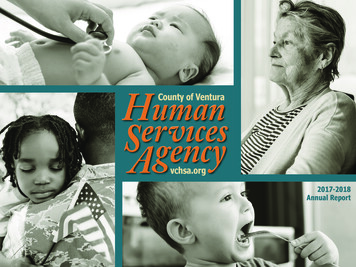
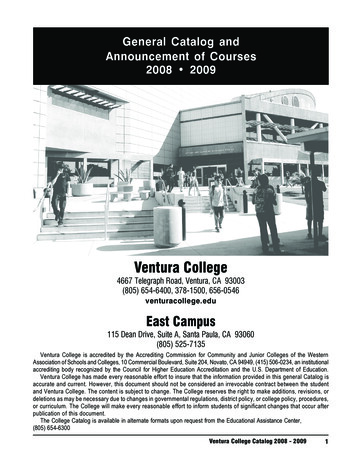
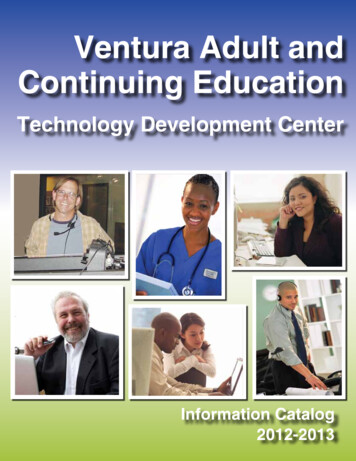

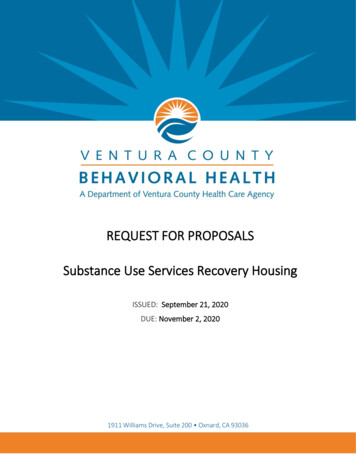

![[TAY SERVICE GUIDE] - Ventura County](/img/26/tay-community-services.jpg)

